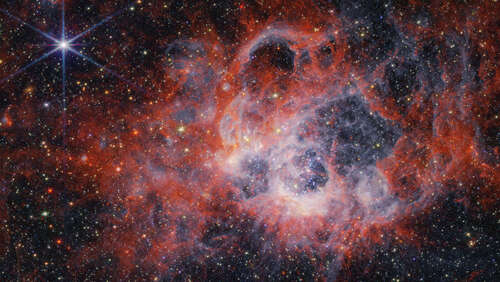
The James Webb Space Telescope took several images of NGC 604 using its Near-Infrared Camera (NIRCam) and the Mid-Infrared Instrument (MIRI). All four of Webb’s instruments operate in the infrared wavelength, which is the part of the electromagnetic spectrum beyond visible light. Infrared wavelengths are longer than those we can see.
That enables the telescope to see things that would be invisible in visible light (or the optical wavelength). Telescopes like Hubble operate in the optical, so having Webb, which can see in the infrared is complementary. As the names of Webb’s instruments suggest, they operate in different parts within the infrared spectrum: the near-infrared and the mid-infrared. This is why the two instruments get slightly different views of the same object as they look at different wavelengths they see different phenomena.
The image at the top of the page, for example, is the NIRCam image, and it shows molecules called polycyclic aromatic hydrocarbons in orange. It also shows molecular hydrogen in red, where the stars are forming, and ionized hydrogen (which experiences ultraviolet radiation) in white and blue.
The image in this section is from MIRI. The glow here comes from the cooler gas and dust packed around the center of the region.

